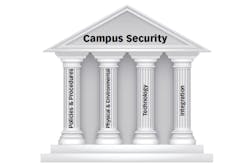Over the next few weeks more than 20 million college and university students will make their way back to campus for another year of study. While the vast majority of campuses are generally safe places, consider:
- In the first half of 2013, at least a dozen students were shot or killed in campus incidents across the U.S.
- According to FBI statistics, there were 92,965 crimes reported to college and university campus police in 2010. Most were property crimes, but there were also reports of murder, rape, aggravated assault and robberies.
- The U.S. Department of Justice reports that one in five women will be victims of an attempted or actual sexual assault during their college careers.
Statistics such as these understandably concern parents. Campus administrators and police share those concerns and most are taking reasonable precautions to protect students, faculty, staff and visitors. Since the passage of the federal Clery Act, we have a better way to compare campuses. The act requires all publicly funded colleges and universities to issue an annual report on campus crime. Those reports can be found on individual campus websites.
Campus security can be broken into four broad areas — policies and procedures; physical and environmental factors; technology; and, integration. The security process begins with an annual risk assessment, a systematic evaluation that may involve thousands of inspection points on a larger campus. It’s best conducted by an experienced outside expert who can bring a fresh eye to the review of those fundamentals that play a vital role in securing a campus. And remember, creating a safe and secure college or university campus requires buy-in from the entire population, beginning with top administrators.
Policies and procedures
What can go wrong on a college or university campus is limited only by imagination. The federal government now identifies many different scenarios that might trigger a campus lockdown.
During a major emergency, count on all segments of the campus population becoming involved. Staff, faculty and even students may play a role in communications, traffic control and monitoring muster stations. This is where detailed playbooks provide the policies and procedures for handling events ranging from minor events to full-blown campus-wide emergencies. Once the playbooks are written, it’s important to hold regular drills to make sure everyone understands their role in various scenarios.
Most campuses are part of a much larger community, so it’s vital to maintain close contacts with local law enforcement and other first responders. These authorities need to know who to contact at the campus during an emergency and they can respond more quickly and effectively if they have updated campus maps and building blueprints.
Physical and Environmental Factors
In creating a security plan, a campus’ unique size, topography, climate and other physical and environmental factors will come into play. The risk assessment will identify these factors.
Dark or remote campus areas can be improved by proper lighting, a low-tech, yet critical component of a good security plan. A risk assessor will walk the campus looking for those spaces that pose security dangers or even liability risks if not properly lit. Bright lighting should extend to parking lots, walkways, recreation sites and other isolated areas.
Most risk assessors will include a section on crime prevention through environmental design (CPTED), another low-tech approach to security. Trees and other vegetation should be thinned and cut back so they don’t block views into buildings, nor provide a place for criminals to hide and/or conceal weapons.
Technology
Access control systems are a key element of a well-planned campus security program. An access system can remotely lock and unlock main entries at appropriate times. When not in use, all buildings should remain locked. Open, unstaffed buildings provide a tempting target for thieves and other criminals looking for a place to conduct business.
Cardkey-controlled entries should also be required for all dormitories as these systems offer a number of advantages. Lost or stolen cards can be immediately deactivated and a new card issued within minutes, eliminating the expense and time of rekeying locks. Administrators should select a smartcard system that will give students not only dorm access, but also entry into laboratories, recreation centers, offices and other buildings. These cards can be programmed to allow access only on specified days and times. Access systems also maintain an audit trail that can be valuable in investigating a crime.
Visitor management systems are another important layer of security for campus buildings, especially dormitories. Many visitor management efforts begin with a video intercom. These systems allow campus personnel to remain safely behind a locked door while still being able to see and communicate with visitors. Video intercoms are useful for remotely granting access to vendors and contractors needing entry into dorms, cafeterias, loading docks, storage buildings and other campus facilities.
A web-based visitor management system uses campus- or government-issued photo IDs to check visitors entering critical areas. The cards are swiped through a reader connected to federal and state criminal and sex offender databases. Once the visitor is cleared, the system takes the visitor’s photo and prints a self-expiring, adhesive badge that can be worn throughout the stay. The systems also make it easy to program a local watch list that could include disgruntled individuals such as fired employees or suspended/expelled students.
Mass notification systems provide students, faculty, staff and visitors with vital information and instructions to follow during an emergency. A campus should employ both web-based communication tools and external “big voice” systems. A web-based system allows administrators to send notifications to thousands of people in minutes via the registered recipient’s landline, mobile phone, PDA/text-based device and e-mail account. A system can even remind students of counseling or health services appointments, fee due dates and other campus activities.
Outdoor systems are capable of covering a campus with only a few speakers, each capable of being clearly understood up to a quarter-mile away. By providing information when it’s most needed, both systems can help save lives and preserve property.
Another important tool is video surveillance, which gives campus police valuable real-time data to lessen the impact of or resolve criminal acts. Clear, noticeable signage stating an area is under surveillance also can help cameras act as a significant deterrent to many criminals.
Cameras should be placed at entries to all dorms, classrooms, office buildings, labs, gyms, stadiums, libraries, student unions, parking lots, and remote campus areas. When mounted on portable trailers, cameras can be moved to where they are needed for special events such as sporting events, concerts or other attractions that can draw thousands of people from surrounding communities.
Today's digital and networked systems provide for remote viewing of live and recorded video allowing authorized administrators to check on the campus from other locations. Officers in the field can view real-time video on smartphones and tablets. Local first responders can also share that same data helping them to better prepare for a potentially dangerous situation.
Integration
By placing all the previously mentioned disparate technology systems on the campus network it’s possible to integrate them for a more efficient and effective security response. For example, an access control reader can trigger an alarm that starts the nearest camera to begin streaming live video of the site to campus police. Floor plans or maps of the location can accompany the real-time feed to give dispatchers important details to correctly handle a situation.
Many campuses already employ electronic campus credential solutions that allow a student’s access card to also be used to check out library books, buy supplies from the bookstore, access parking facilities, attend cultural or sporting events, use a copier or purchase vended products or food from on- or off-campus sites, so students no longer have to carry cash or multiple debit/credit cards. An access control solution that is integrated with the campus “one card” solution can help to eliminate the data and timing gaps created when multiple systems and credentials are used for differing purposes, thereby creating a safer, more convenient campus.
It’s now even possible, and advisable, to integrate security with building management systems. For example, if the fire alarm system detects a fire, the building automation system signals the heating, air conditioning and ventilating system to stop delivering fresh air to the area and pressurizes the path of egress, clearing it of smoke. The access control system will unlock doors along the route and train surveillance cameras on the fire to provide first responders with a live feed.
There are a couple of other security steps that have proven effective on college and university campuses as well. Easily recognizable emergency contact stations, placed at regular intervals across campus, provide an immediate visual and video connection to campus police. A police escort should be available to any student to help them safely navigate the campus day or night.
Creating a secure college and university campus is all about planning and preparedness, but it’s not a one-size-fits-all process. Starting with a risk assessment, the security team needs to create the policies and procedures that fit that campus. When it comes to security, there are no guarantees of total success, but by adhering to these proven best practices, it’s possible to tremendously improve a campus’ safety and security profile.
About the Author: Patrick V. Fiel, Sr. is an independent security consultant, having served as public safety advisor for a large national security integrator; executive director of security for the Washington, D.C. Public School System; and is retired from the U.S. Army Military Police Corps. He is currently working with education technology solutions Blackboard Inc. For more information, visit bbbb.blackboard.com/transact_2013_Webinars)
About the Author

Patrick V. Fiel, Sr.
Former Executive Director of Security for Washington, D.C. Public Schools
Patrick V. Fiel Sr., a national security expert with more than 40 years of experience in law enforcement and security management, is a retired member of the U.S. Army Military Police Corps. He is available to speak on risk assessments, active shooter preparedness and security best practices. He can be reached at (910) 789-4265 or [email protected].
